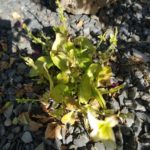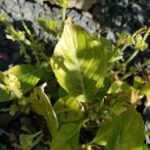Q.What Type Of Plant Is This?
So this plant was just dead sticks when we bought our house, but we noticed it seemed to be growing a new plant underneath it. So we trimmed away the dead sticks and have been letting the new one grow. The leaves were scorched by the summer sun, hence the lack of leaves. Are you able to identify it? We’d love to know what it is but can’t quite figure it out.

It appears to be a hydrangea of species macrophylla or serrata. Hydrangea macrophyllas (also known as Big Leaf Hydrangeas, French Hydrangeas or Hortensias) are almost identical to hydrangea serratas (also known as Mountain Hydrangeas) but serratas tend to be smaller, leaf out and bloom later than macrophyllas and the majority of the time produce blooms of lacecap form (a small number of serratas produce mophead form blooms). Because your specimen is currently small enough, it could be either of those to but not to worry. The care for them is almost identical. Macrophyllas produce one of those two blooms forms (lacecap or mophead)but are most widely known for their mophead blooms. Because your specimen is currently small enough, it could be either of those to but not to worry. The care for them is almost identical. The following comments apply to both.
The hydrangea in the picture appears to have a multitude of problems such as inconsistent watering (heat stress), Cercospora leaf spot, iron chlorosis and should not be planted using rocks as mulch.
Any one, a few or all of the following scenarios can cause heat stress. Normally the problems are more common in the summer months but can occur at any time of the year. (1) too much sunlight – except for hydrangea paniculatas that are more sun tolerant, hydrangea should be planted where they get dappled sun or morning sun in the summer months. Try to get shade by 10-11am or thereabouts during the summer months. (2) lack of water, lack of enough water or inconsistent watering can result in leaf drop and new leaves growing at the end of the growing season. Aim for soil that is as evenly moist –not wet, not dry, just moist- as you can make it. Hydrangea roots are shallow and grow as deep as 4-5” only. To know when to water: insert a finger into the surrounding soil at a depth of 4” and water of the soil feels dry or almost dry. To see if you watered enough: (a) water when the previous finger method test indicates that the top 4” feels dry. (b) allow some time for the water to drain. (c) insert a finger into several spots around the plant to a depth of 8” to see of the soil feels dry, moist or wet. If the soil feels dry, the soil may drain slowly or too fast (sandy soils), you may have missed spot when watering or you may not have used enough water (if so, use more water the next time that you water). (3) too much win – windy locations can dry out the top few inches of the soil easily, especially during the summer so maintain 2-4” of organic mulch (no rocks) around the plants all year long to minimize soil moisture evaporation and protect the roots from extreme cold & hot temperatures. (4) lack of water, lack of enough water and/or inconsistent watering that does not keep the soil evenly moist can make the big leaves droop and if the environment does not improve, the leaves may brown out from the edges inwards until they completely brown out and drop. New foliage will develop when conditions improve or in the following spring. (5) daytime temperatures above 85°F can make the leaves lose moisture faster than the roots can absorb more water and this will make the leaves droop/wilt.
How to water: Water early in the morning between 6-8am so the foliage and blooms do not remain wet for long periods of time. Start watering near the crown/base of the stems and water in circle outwards. It is hard to estimate how much water is needed but hydrangeas, azaleas and camellias usually need several gallons of water per plant per water once they are established in the garden. You can try 1-2 gallons during spring. Then increase the amount of water to “summer levels” once daytime temperatures are typically above 85°F. If daytime temperatures are typically at or above 95°F, consider aaaalso hand watering sometimes. As temperatures recede and are typically below 95°F, discontinue the hand waterings but continue watering at summer levels. As daytime temperatures stay typically below 85°F, revert back to watering at spring levels. As the plants begin to lose foliage and go dormant, reduce waterings to once a week or once every two weeks depending on local rains. If the soil freezes in your zone 6b/7a, stop watering. Restart watering at spring levels when you see new growth and the soil has thawed.
About rock mulch: Do not use rock mulch until the plants are fully well established. Not recommended in the southern states if the temperatures get very hot in the summer. Rocks absorb heat during the day and release it at night. But night time is when wilted/droopy leaves and the shallow roots expect to get some respite from heat stress during the summer days. So, use organic mulch instead. Organic mulch helps retain moisture better than rocks and helps feed established hydrangeas… off the decomposing mulch.
About the leaf spots: Cercospora leaf spots are caused by overhead watering and leaves that remain wet for too long. They are always present on the leaves but become visible in late summer when chlorophyll production is reduced enough to make them visible again. Avoid this problem by never watering the leaves if you can. You can use fungicides for control but it may be less costly to use clean sanitation practices if you only have one plant. Water using soaker hoses or drip irrigation; or set the sprinkler to water between 6-8am only. Examples of clean sanitation practices: avoid overhead watering; do not overwater; pick up plant debris and throw away in the trash instead of on a compost pile; cut off leaves that are very diseased by cutting off the petiole string that connects the leaf to the stems; do not use very high nitrogen fertilizers (a slow release, general purpose, chemical fertilizer with a NPK Ratio of 10-10-10 is adequate or apply a cup of cottonseed meal, organic compost or composted manure. Apply only once in spring after your average date of last frost… about 1st week in June for Boise… but stop all fertilizers about three months before your average date of first frost… about 3 months before the first week in October or mid July); avoid planting shrubs close enough to other shrubs such that the leaves comingle or touch (unless you are making a hedge, of course).
About iron chlorosis: If your soil is alkaline (soil pH less than 7.0), the normally dark green leaves turn yellow or light green, except for the main leaf veins which remain dark green. If the problem persists, the leaves may turn white, except for the main leaf veins which remain dark green. Apply some iron-chelated liquid compounds, garden sulfur or aluminum sulfate (keep the a/s away from azaleas and rhododendrons though) according to the product label directions. These products are normally found in most plant nurseries. Note: they are normally slow to correct the leaf problem but they will in time.
About the sticks: hydrangea stems may succumb to lack of water or temperatures that are too frigid in winter. If they do not leaf out by mid to late May, you can cut them all the way down. Some people in z6 and colder sometimes winter protect hydrangeas to protect blooms. Hydrangea spring 2020 blooms develop in late summer or early fall 2021 at the ends of the stems (inside the stems so they are not visible now) but they do not open until spring/summer. Rebloomer varieties may develop blooms off brand new stems that start growing in the spring 2022 but these may bloom later, like mid to late summer or fall.



